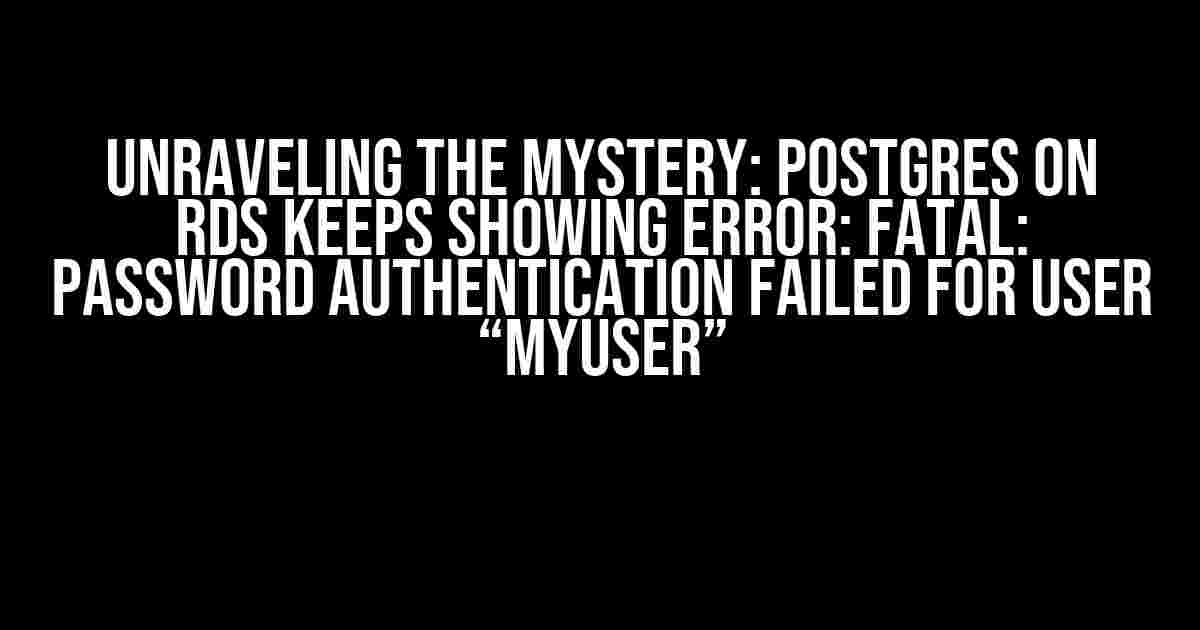Are you tired of banging your head against the wall, trying to figure out why Postgres on RDS is throwing that pesky “FATAL: password authentication failed for user ‘myuser'” error? Worry not, dear reader, for we’ve got the solution to this frustrating problem right here!
What’s Causing the Error?
Before we dive into the fix, let’s quickly understand what’s causing this error. When you try to connect to your Postgres database on Amazon RDS, the error message suggests that the password authentication is failing for the specified user, “myuser”. This can occur due to a variety of reasons, including:
- Incorrect username or password
- Invalid password encryption
- Missing or incorrect IAM roles
- Firewall or security group restrictions
- Credentials not properly updated in the RDS instance
Step 1: Verify Username and Password
The most obvious culprit is the username and password combination. Double-check that you’re using the correct credentials:
psql -h your-rds-instance_name-CPUSCELWCLQ5X4QMJ2GFJ7RH74.amazonaws.com -p 5432 -U myuser yourdatabase
Replace “your-rds-instance_name-CPUSCELWCLQ5X4QMJ2GFJ7RH74.amazonaws.com” with your actual RDS instance endpoint and “yourdatabase” with the name of your database.
Step 2: Check IAM Roles and Permissions
Make sure the IAM role associated with your RDS instance has the necessary permissions:
Create an IAM role with the following policies:
{
"Version": "2012-10-17",
"Statement": [
{
"Sid": "VisualEditor0",
"Effect": "Allow",
"Action": [
"rds:*",
"iam:PassRole"
],
"Resource": "*"
}
]
}
Attach the IAM role to your RDS instance:
| Action | IAM Role |
|---|---|
| Create RDS instance | rds-launch-wizard-* |
| rds MODIFY-* |
Step 3: Update Credentials in RDS Instance
Ensure the correct credentials are updated in the RDS instance:
Step 1: Connect to your RDS instance using the AWS Management Console.
Step 2: Navigate to the “Instances” tab and select your instance.
Step 3: Click on “Instance settings” and scroll down to the “Database authentication” section.
Step 4: Update the master username and password.
Note: After updating the credentials, make sure to restart the RDS instance.
Step 4: Firewall and Security Group Configuration
Verify that the security group associated with your RDS instance allows inbound traffic on the specified port (5432 in this case):
Type: PostgreSQL
Protocol: TCP
Port Range: 5432
Source: 0.0.0.0/0, ::/0
Step 5: Encryption and SSL/TLS Configuration
If you’re using SSL/TLS encryption, ensure that the correct certificate is installed and configured:
Step 1: Obtain the SSL/TLS certificate from your certificate authority.
Step 2: Create a Certificate Authority (CA) in AWS Certificate Manager (ACM).
Step 3: Import the certificate into ACM.
Step 4: Associate the CA with your RDS instance:
aws rds modify-db-instance \
--db-instance-identifier your-rds-instance \
--ca-certificate-identifier your-ca-arn
Step 5: Update the PostgreSQL configuration to use SSL/TLS:
ALTER SYSTEM SET ssl = on;
ALTER SYSTEM SET ssl_ciphers = 'TLSv1.2:';
ALTER SYSTEM SET ssl_prefer_server_ciphers = on;
Step 6: Verify Connection
Finally, try connecting to your Postgres database on RDS using the updated credentials and configuration:
psql -h your-rds-instance_name-CPUSCELWCLQ5X4QMJ2GFJ7RH74.amazonaws.com -p 5432 -U myuser yourdatabase
If you’ve followed these steps correctly, you should now be able to connect to your Postgres database on RDS without encountering the “FATAL: password authentication failed for user ‘myuser'” error. Pat yourself on the back, you’ve earned it!
Conclusion
In this article, we’ve walked you through the most common causes of the “FATAL: password authentication failed for user ‘myuser'” error in Postgres on RDS and provided step-by-step instructions to resolve the issue. By following these troubleshooting steps, you should be able to identify and fix the root cause of the problem, ensuring a smooth and secure connection to your Postgres database on RDS.
Acknowledging the frustration that comes with encountering this error, we hope this article has been helpful in resolving the issue and saving you valuable time and effort. Happy troubleshooting!
Have you encountered any other errors while working with Postgres on RDS? Share your experiences and tips in the comments below!
Here are 5 Questions and Answers about “Postgres on RDS keeps showing error: FATAL: password authentication failed for user “myuser””:
Frequently Asked Question
We’ve got the scoop on solving that pesky Postgres on RDS error!
Q1: What’s the deal with this error? Is it a typo?
Don’t worry, it’s not just a typo! The error “FATAL: password authentication failed for user ‘myuser'” usually indicates that the password for the user “myuser” is incorrect or not properly configured. Double-check your password and make sure it’s correct, and then try again.
Q2: I’ve checked my password, and it’s correct! What’s going on?
Hmm, okay! In that case, check if the user “myuser” has the correct permissions and access to the database. Make sure the user is granted the necessary privileges and can connect to the database. If you’re still stuck, try resetting the password or checking the database logs for more clues!
Q3: I’m using AWS RDS, could that be the issue?
Yeah, that’s a good point! When using AWS RDS, make sure you’ve configured the database instance to allow password authentication. Check the RDS instance settings and ensure that the “password authentication” option is enabled. Also, verify that the VPC security group rules allow incoming traffic on the PostgreSQL port (usually 5432).
Q4: What if I’ve already checked all these and still get the error?
Time to dig deeper! Check the PostgreSQL logs for more detailed error messages that can help you identify the issue. You can also try testing the connection using the `psql` command-line tool or a GUI client like pgAdmin. If you’re still stuck, consider reaching out to AWS support or a PostgreSQL expert for further assistance.
Q5: Is there a way to avoid this error in the future?
Absolutely! To avoid this error in the future, make sure to use strong, unique passwords for your database users, and consider using AWS IAM authentication instead of password authentication. Additionally, regularly review your database permissions and access controls to ensure they’re up-to-date and secure.

